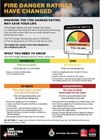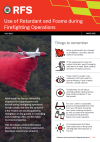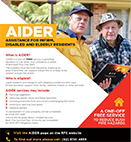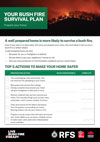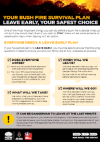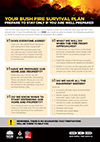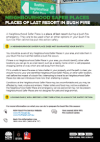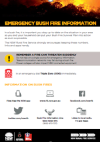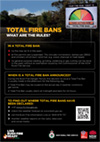Fact sheets
We produce a wide variety of fact sheets, including fact sheets on bush fire safety, land management, communities at risk, tourism and recreation, home fire safety and farm fire safety.
A variety of our fact sheets are available in languages other than English on our translated fact sheets page.
Fire Danger Ratings have changed
The Fire Danger Ratings give you an indication of the consequences of a fire, if a fire was to start. Knowing the Fire Danger Rating may save your life.
Use of Retardant & Foams during Firefighting Operations
Get Ready For A Bush Fire
Getting ready for a bush fire is easier than you think. By taking 20 minutes with your family to discuss what you’ll do during a fire, you could save their lives, as well as your home.
Assistance For Infirm, Disabled and Elderly Residents
Prepare Your Home
A well prepared home is more likely to survive a bush fire.
Leave Early, Your Safest Choice
Everyone needs a leave early plan.
Prepare to Stay
One of the most important things you can do before a bush fire is decide what you will do if one should start. If your household plan is to STAY, you must be able to answer the following questions in detail to ensure you and your family are prepared as possible.
NSPs - Places of Last Resort
A Neighbourhood Safer Place is a place of last resort during a bush fire emergency. They are to be used when all other options in your Bush Fire Survival Plan cannot be put into action safely.
Emergency Bush Fire Information & Alert Levels
In a bush fire, it is important you stay up-to-date on the situation in your area so you and your household can put your Bush Fire Survival Plan into action as soon as possible.
Total Fire Bans
If you ignore a Total Fire Ban, people may die.


